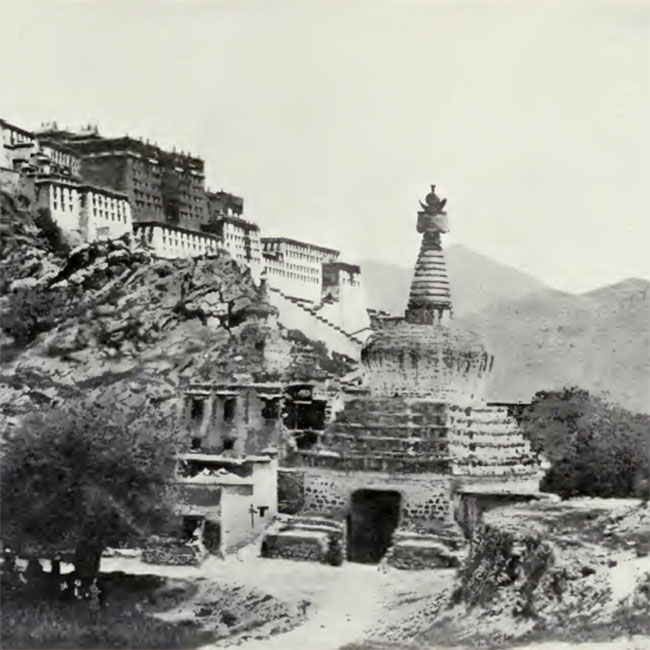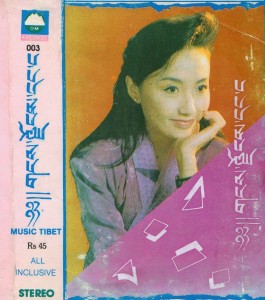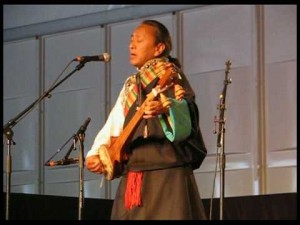In my post “Lhasa: Eternal City 2”, I mentioned how the destruction of the Drago Kaling Stupas, the Gateway to Lhasa, had inspired the first “protest” song in the Tibetan freedom movement. I requested readers to help me locate the original song sung by Dadon la. Two readers, Tenzin la (in exile) and another person from Lhasa, (who requested anonymity) both kindly sent me the song files. I contacted Techung la to help me with the translation of the song into English, and he managed to get Dolkar la of RFA to first help him transcribe the original Tibetan lyrics which are not all that clear in the song. A friend from Lhasa also informed me about the identity of the songwriter, who I think I will withhold for the time being. Woser la also managed to get the lyrics translated into Chinese, which she has included in one of her posts.
The first version is the original song sung by Dadon la. The cover image of Dadon la is from an old cassette pirated and sold in India. I have reproduced it to give young readers an idea of how primitive the fledgling Tibetan music industry was in the eighties. But the cover art does have a charm of its own, as does her retro-bouffant.
The second version of the song sung by Tenzin Gompo is from his CD, In Memory of Tibet. Tenzin Gompo la is a an enormously skilled and versatile singer and performer based in Paris, who has introduced the French public to the ancient performing traditions of Tibet.
མཆོད་རྟེན་བྲག་སྒོ་ཀ་གླིང་།
བརྗིད་ཆགས་པོ་ཏཱ་ལ་ཡི་མདུན་ལ། བརྩེ་བའི་མཆོད་རྟེན་གསུམ་ཡོད།
དྲིལ་བུ་སྐད་སྒྲ་སྙན་པ་ལ། དྲིལ་བུ་སྐད་སྒྲ་དེ་འདྲ། དེ་འདྲའི་སྙན་པ་ལ།
ཨཱ་ཨཱ། མཆོད་རྟེན་བྲག་སྒོ་ཀ་གླིང་། ཨཱ་ཨཱ། ང་ཡི་སེམས་ལ་ལྷང་ལྷང་དྲན།
ང་ཡི་ལ་ནི་སེམས་ཀྱི་སྟེང་ལ་ཁྱེད་ནི་ལྷང་ལྷང་དྲན་བྱུང་།
ཕོ་བྲང་གསེར་འོད་ལ་ཡི་ཆེམ་ཆེམ། རྒྱལ་སྒོ་བྲག་སྒོ་ཀ་གླིང་།
སྒོ་མོའི་ནང་དུ་འཛུལ་ལ་པས། གྲོང་ཁྱེར་སྔ་ཉམས་དོད་པ། དེ་འདྲའི་དོད་པ་ལ།
ཨཱ་ཨཱ། མཆོད་རྟེན་བྲག་སྒོ་ཀ་གླིང་། ཨཱ་ཨཱ། ང་ཡི་སེམས་ལ་ལྷང་ལྷང་དྲན།
ང་ཡི་ལ་ནི་སེམས་ཀྱི་སྟེང་ལ་ཁྱེད་ནི་ལྷང་ལྷང་དྲན་བྱུང་།
དད་ལྡན་མང་ཚོགས་རྣམས་ལ། དད་པའི་རྟེན་ཡང་དགོས་ཀྱིས།
མཛེས་པའི་ལྷ་སའི་རྒྱན་ལ། བྲག་སྒོ་ཀ་གླིང་དགོས་ཀྱིས།
མཛེས་པའི་ལྷ་སའི་རྒྱན་ལ། བྲག་སྒོ་ཀ་གླིང་དགོས་ཀྱིས།
In front of the Potala Palace
There were three beloved stupas
Whenever the wind stirred the chimes
What resounding music there was,
How melodious it sounded
Aah stupa Drago Kaling
Aah, in my mind I suddenly remember
In the depth of my heart I suddenly remember you.
The golden light from the palace sparkles and shines
When you enter the Gateway Drago Kaling
(You see) The city so grand and majestic
How magnificent it all looked
Aah stupa Drago Kaling
Aah, in my mind I suddenly remember
In the depth of my heart I suddenly remember you.
The devoted and faithful people
Need an object for their belief
Our beloved Lhasa,
needs the Drago Kaling for its beauty
到了布達拉宮前,思念起姹谷戈林;鈴聲曾經那樣的悠揚,我的心忧伤起来。啊,宝塔姹谷戈林,三座萬眾鍾愛的寶塔,啊,宝塔姹谷戈林,我像是见到了你的容颜。當輕風吹過風鈴,思念起姹谷戈林,阳光曾经那样的照耀,众人多么忧伤。啊,宝塔姹谷戈林,三座萬眾鍾愛的寶塔,啊,宝塔姹谷戈林,我要向你献上供奉。(此歌詞大意由茨仁唯色女士整理提供)
There is a story of why the Drago Kani stupa was first erected and why it is so vital for the overall spiritual welfare of the Holy City. In the middle of the Lhasa valley floor rises two steep hills, Marpori (the Red Hill), on which stands the Potala, and Chakpori (the Iron Hill) on which the Medical College was built. The Lhasa Atlas states that these hills function as landmarks and project an extraordinary power across the wide plain. According to the ancient Tibetan tradition of geomancy (sa-bshad), the gap between the two mountains created an inauspicious space that had to be filled in order to unite the two vital geographical features of the city. Hence the three stupas were built to bring the two hills together.
In the Tibetan tradition there are eight different kinds of stupa each referring to a major event in the Buddha’s life. Looking at old photographs and comparing them to stupa drawings in Robert Beer’s The Encyclopedia of Tibetan Symbols and Motifs, the Drago Kaling stupa appears to be of the kind known as the “stupa of reconciliation” This stupa commemorates the Buddha’s resolution of a dispute among the sangha. A stupa in this design was built in the kingdom of Magadha, where the reconciliation occurred. It has four octagonal steps with equal sides.
(This brief post about the Drago Kaling stupa and the protest song itself is offered here to honor the Tibetan singers, Pema Trinley la, 22, and Chakdor la, 32, who have been recently sentenced by Chinese occupation authorities to two serve two years in prison for their songs describing the ongoing self-immolation protests.)






Thank you, Jamyang la,
It brought back lot of memories of old days in India when few people have tape recorder. We have only few songs to play like this one and Rangzen shunu.
AGU
Come on, Jamyangnorbu..don’t create disunity in Tibetan politics by rehashing ancient songs and history of Lhasa. We don’t want to know anything about Tibet’s past. We want to look forward to the future where we will be considered same as Han Chinese and carry a Chinese passport. Don’t destroy our Unity with the motherland China.
Really thank for cover just very critical and important information about the destruction in lhasa. We really appreciate this types of article written by your. and always Disagreed with the criticism for H.H and CTA.
thank you
@Tsering Dolker Please sister next time when you use the word “we” Please Please Please think again, ’cause i am sick of people like you always using the title of public, honestly what do you know about Tibet?
FYI i hate your motherland from the bottom of my heart
Looks like Tsering Dolkar caught a big fish.
Thank you JN la. I’m also liking the bouffant retro hairstyle of Dadon la a lot. not quite mad men retro but still good.
Enjoyed your post and the songs. Keep it up. Thanks.
@Tsering Dolkar, even though you are born in form of Tibetan, no one in this world tells you to stay away from Chinese fecal. Or converted in Tibetan Buddhist & offers you of name long life goddess eating every creature on this earth & even human flash during your culture revolution & destroyer of our universe which is your root of Confucius.